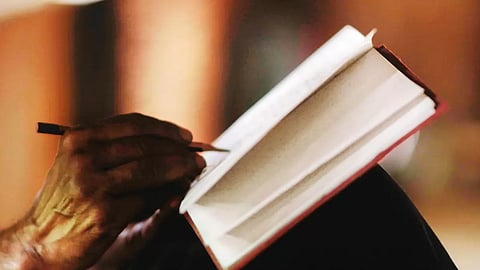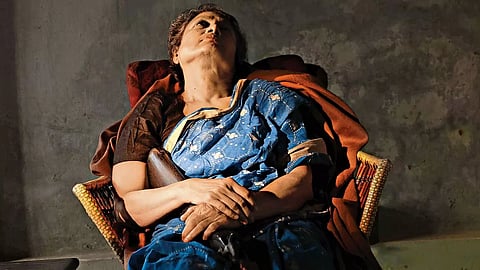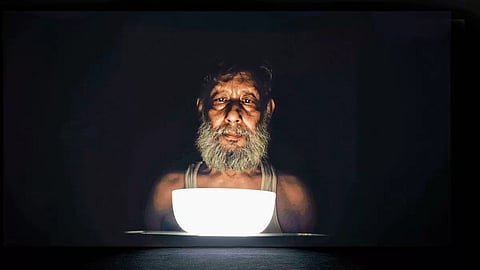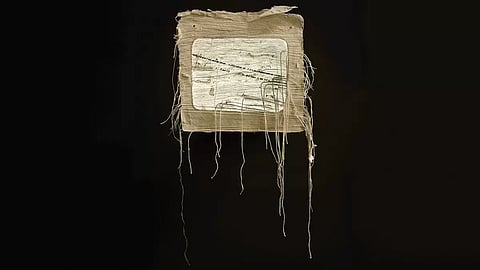When night becomes day, and cities become prisons, and farmers become masons, and lovers become soldiers, and gods become demons, and guns become pastries, and intuitions become diseases, and as words lose meaning, then which truth can guide? The one you see in the daylight with eyes wide open or the one possible to only see in pitch darkness? What conversation begins when everything has been said, and with whom? What is it that lies beyond when all arguments are over? Which fact, which fantasy becomes the plumb line that gets dropped into the infinity of our bottomless well?
Such A Morning
A contemporary parable of a mathematician’s experiments with truth
One day, an old professor disappeared. It was unexpected, he was at the peak of his career, a famous mathematician. There was no clear reason why and no clue about where he went. A thousand speculations exploded. Everyone had a point of view. Why did the man leave? Some said it was a financial matter, others condemned him to the scandal of a lost love. A sleight of mind, a passionate deception, did someone steal his confidence?
The Dean offered a puzzling explanation. He said it was a deep inner question of the soul. The Professor was a ‘misfit’ and so had left. No one agreed but no one disagreed either. Someone did say that there was no such thing as a soul but since it was not said to anyone in particular, it was assumed to have not been said at all.
The Department of Psychology pronounced that he was ‘incapable of being happy’. A final answer, a diagnosis to end all discussions but the speculations continued. It seemed that the people he had left behind were uncomfortable, and even angry, as if he had betrayed them, as if a grave crime had been committed.
One day, the Academic Council proclaimed that he had left because of a political dispute. The letter stated that it was ‘a complex conflict of ideology and prejudice’. Suddenly, the Department of Philosophy objected and said that violence has no ideology. This statement confused everyone and the speculations erupted again.

Several days later, the Proctor suggested a fire ceremony to purify the buildings and the minds of those left behind. This now spooked everyone and all further speculations became murmurs. The murmurs soon became whispers, and the whispers eventually became mosquitoes. Forever in search of blood.
There was another theory that was proposed. It could be that the professor was slowly losing his eyesight and had decided to withdraw into darkness so as to acclimatise before total darkness descended. It was a hypothesis that could not be denied. There was even a witness. But this proposition was soon dismissed as unviable. For how long can a man stare into darkness?
The Professor offered no explanation, and instead retreated inside an abandoned train carriage not too far from the city. Covering up the windows of the compartment, he began to live in complete darkness. Silent and alone, he slept for days, or maybe it was for weeks. Darkness began to surround him, seeping down the walls, sliding through the train carriage, curving around him. As time passed, thin streaks of fire like arrows began to fall. Dust became gold, thoughts turned into sound, the train began to move and a phantom
vision swept through the carriage. The hallucinations were electric.
High up on a mountain, in a beautiful wooden house surrounded by purple, pink and white flowers lived a woman all by herself. She had a book, a gun, a candle, a key and a box of seeds. Always on guard and always reading. One day, a group of men, workers, suddenly appeared and began dismantling her house. Piece by piece, door by window, her house came apart but she kept on reading. What was she reading, was it his story?

Meanwhile a war broke out. It ended and immediately began again. People were confused because everyone was celebrating. Every now and then, a roar swept across the valley. The living were killed rapidly and the dead came back to fight again. Gangs of possessed men slipped out into every street. And then, it all became quiet again because no one was quite so sure who was who anymore.
The Professor began to write in his Almanac of the Dark. These notes soon became letters which the crows delivered, working furiously like a post office. The first letter was to his colleagues
Dear Colleagues
In the face of your brutality, may I say, with the utmost respect, that all numerals are only patterns and these patterns are simply replications and each replication is deeply interconnected and all interconnections are in a constant flux and that within this flux, what is permanent is that nothing is permanent.
To his students he wrote
Dear Students,
There is a train in the wilderness within which the further you go the closer you get.
To the Chancellor of the university, he wrote,
Dear Chancellor,
I write to you from the depths of darkness. May I humbly inform you that I think the curriculum of the university needs to be changed. It is now clear to me that there are 49 types of darkness. 21 of these are within and the rest are on the outside. I would recommend base studies in all of these so as to prepare for a new journey of learning. Without which we will continue on this path of self-destruction.
To the children in his street, he wrote,
Dear Children,
High up on a mountain above the clouds is a house with many windows. Adjacent to the house is a patch of the beautiful Cosmos flower. Originally from Mexico, the flower now grows wild all over the world. When it rains the petals curve inwards to protect the centre, when the storm winds blow the tall stems dance and bend but never snap. There is a little white one growing there, with special nectar that cures all who cannot see anymore.
As the crows flew across the sky carrying letters from the Almanac of the Dark, the powerful and their sidekicks began to tremble. It was such a morning, a morning of absolute uncertainty. The Professor kept on writing.
Dear Sir,
The word drifts away, a distant mark in the ocean.
The soft light of the moon slides along the surface of the water, tracing its path.
In the darkness a mass of land silently dislodges, slips into the water and floats away in quiet pursuit.
I have been guided by your light for long now. My eyes fixed on your halo, my ears tuned to your voice, my mouth formed by the shape of your word.
At daybreak your word reaches the edge of the horizon, tips over and free-falls into space.
In a while, the mass of land tumbles over with all its people, cars and buildings.
And following it, in the far distance, is you.
Sincerely yours,
A former disciple
And then, finally, the last letter, as the past, the present and the future spun and collapsed within itself, he wrote.
Dear Friends,
The invitation for the meeting was short and cryptic. You could take a train, bus or even a plane to a nearby town, but from there on, other ways of travel would need to be planned. It was obvious that duration and the slowness of travel was part of the objective. Time was inconsequential but the state of mind was.

Like all mountains, this one too seemed much closer than it really was. Before sunrise it would often appear to be in a calm strong grey-blue mood, its immense distance now easy to see. An hour after sunrise, with the snow fresh, visible and uncertain and it was almost younger by a few lifetimes. In the afternoon you could sense thick sloping forests and just before dusk, for a brief moment, when the light and colours changed rapidly, you could see that it wasn’t a single mountain but a series of concentric slopes, folds eventually rising up and within to become an unknown and difficult peak.
The actual base of the mountain was remarkably quiet, even the streams seemed to swish softer. You could hear the breeze because every tree sounded different, the leaves twirled, shook, shuddered in their own little ways.
The bamboo forest had been planted in such a way that it had formed into a huge endless structure with corridors, rooms, gardens and even a large hall. Some parts were filled with light, shade and patterns and others were damp and dark with streams visible and flowing under.
There were rooms for thinkers to sit, for tellers to tell and singers to sing. There were rooms for writers too. A large space was also there, with heating and cooling systems for the ink makers who had come from all over with their powders and liquids. There were some who would only listen. The listeners. They would talk only in response to a question. They seemed to know exactly what was happening. Twice every day all who came would get together as well. The listeners would often sit separately.
The agenda oscillated between being ordered and fluid. You had to listen carefully to trace its structure and follow its disintegration. Every such cycle would leave behind a meaning that was touched, brushed then watched for a while and then left alone to grow, change or disappear.

The first day began on the question of maybe. It seemed, perhaps, that it was possible though it could also be said to not be so.
Several discussions were like two tangents on an invisible circle. Their eventual meeting point was carefully observed and noted. A psycho-historical analysis of the omnipresent phenomenon of arrogance was combined with the living habits of unknown birds. Sudden transformations of intuitions and comprehensions into images, sounds or words were immediately noted.
Calculations to derive the location, dimensions, probability of occurrence, possible trajectory and methodologies to predict, sense and analyse the impact of ‘the blind spot’ were combined with the study of visible and invisible institutions.
Strategies used by individuals and communities to camouflage, conceal, deceive, adapt, survive and resist were studied along with the experiences learnt from the growing and trade of potatoes, onions and medicinal plants.
The study of dictators, their personal lives, and the ideological systems that create them was paired with the knowledge gained from the annual and intergenerational travels of a pastoralist community on a particular route across several fields, forests and nations.
Such an intermingling often created a vast silence that spread long into the night. The urgency of multiple streams racing down the slopes into the rice fields seemed for a moment the only contact with people anymore.
Night was surprisingly spectacular. The stars were near and up close. The wind kept changing directions making the bamboo corridors whistle. The wooden whispers of nightlong tunes and the fragrance of passing clouds cleansed everyone as they slept.

Rules, hierarchies and systems of negotiations between humans, humans and non-humans, non-humans and non-humans were presented in four languages. Three that had scripts and one did not. The transformation of meanings between them was examined carefully.
Then began three days and nights about murders. Carefully selected but across all beings. Described carefully, analysed in great detail and lamented in verse and song too.
By now, the inks were ready. Crushed, mixed, boiled, diluted, thickened, tested. In total, 49 inks were created. Hard black, blue black, brown black, grey black, soft crusty black, striped sparse black, reddish black and so on, the little bottles kept getting filled up and the writing began. A teller and a singer would accompany each set of texts for all that was not possible to write. The second invitation was drafted, the date for the next meeting was announced. Four seasons of time was allocated. Just a little over a year was left to search, identify, make collaborations and develop the curriculums for the 49 base studies into darkness.
Such a Morning is currently showing at the Kochi-Muziris Biennale 2022-23. Presented in Anand Warehouse along the sea, the film installation includes 17 projections and all of the Professor’s letters. The handmade paper for the letters was made by Sherna Dastur.
The train coach built for the film remains in Delhi, a memorial for the teacher who refused to conform, who stepped off the tracks and wandered into the wild.
Such a Morning was edited by Sameera Jain, with cinematography by Dilip Varma and additional cinematography by Ranjan Palit. Sound recording was done by Suresh Rajamani and Julius Basaiawmoit and design by Sherna Dastur. Such a Morning was produced with the support of the Kiran Nadar Museum of Art, New Delhi.
Amar Kanwar is a filmmaker and artist with an interest in the politics of power, violence and justice